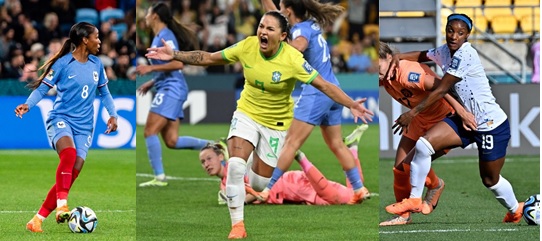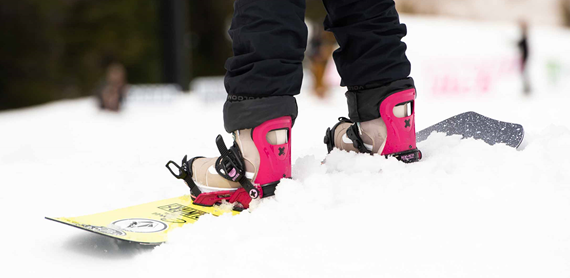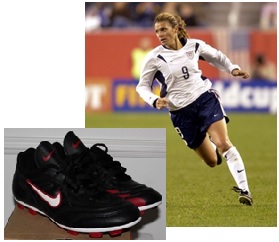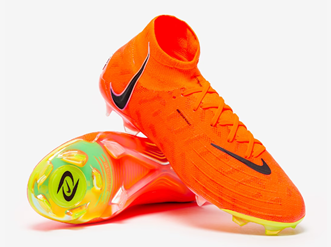Nike launched the first soccer boot designed for women
- What do footballers Grace Geyoro (FRA), Debinha (BRA), or Crystal Dunn (USA) have in common? Probably many things in their passion for soccer, such as all three currently competing in the 2023 FIFA Women's World Cup with their respective national teams in Australia and New Zealand. But this summer, they also share something new: they are among the players using Nike Phantom Luna boots that this brand launched last month in June 2023.

And what's unique about these boots?
They are the first ones designed exclusively for women's feet.
And while we would like this not to be news and not have to explain why such a product is necessary, in this article, we will explain why the launch of these boots is so important and the progress it represents for women's soccer and women athletes in general.
1. DIFFERENCES BETWEEN MEN'S AND WOMEN'S FEET
Just as men and women are anatomically different at first glance, from height to hip width, they also differ in the shape of their feet. And although many mysteries in the field of health professionals are yet to be unraveled, we have precise information on this particular matter.
A woman's foot is generally narrower in the heel area compared to a man's foot, and, conversely, wider in the forefoot or instep area (1,2).
Some studies have even measured the differences in detail (3), measuring up to twenty-six parameters and identifying five main differences in women's feet compared to men's:
- Higher arches (6), generally having a higher "bridge."
- Lower height of the big toe (8), requiring less space for this toe in footwear.
- Smaller midfoot circumference (14), making it narrower.
- Shorter horizontal length from the ankle (18), requiring a narrower fit in the area where the foot enters.
- Shorter length from the heel to the head of the 5th metatarsal (22), causing the area where the shoe articulates to extend the toes to be positioned further back compared to men.

Furthermore, they found differences beyond the foot in the ankle and leg areas, which are not relevant for a soccer boot but could be highly significant for other sports, such as designing ski or snowboard boots for women:
- Larger ankle circumference (12)
- Greater calf muscle circumference at the thickest point (11)
- Shorter ankle height (2)
- Lower medial malleolus height (3)
- Shorter distance between malleoli (24)
- Greater height at the point of maximum calf thickness relative to height (1)

2. HOW HAS SPORTS FOOTWEAR FOR WOMEN BEEN HANDLED?
Before discussing sports footwear, let's talk about conventional footwear. Until now, most research on footwear and women has focused on the detrimental effects of wearing high heels. In 1993, the American Orthopaedic Foot and Ankle Society conducted the Women's Shoe Survey (4) with 356 women to study footwear trends among women and their relationship to foot deformities and pain. The results showed that 80% experienced pain while wearing their regular footwear, and 76% suffered from some form of deformity. Therefore, research primarily focused on the influence of fashion, with little attention given to the anatomical differences in women's feet, and even less to women's sports footwear.
With the rise of women's sports and the societal shift toward gender equality, one might have expected that such research would have been conducted by now. However, as an image is worth a thousand words, what the industry has done perfectly reflects it. This slide from Sheree Becker's presentation at Isokinetic, the world's largest congress on football and sports science in 2022, illustrates it:

Instead of designing soccer boots tailored to the female foot's anatomy, as brands did for men, what has been done, and in many cases is still being done today, is to make these men's models smaller and color them pink, a lot of pink.
In 1999, when women's soccer was gaining popularity in the United States, Nike visited the famous star Mia Hamm to get her opinion on the footwear used by women in soccer. As a result, they designed the Air Zoom M9 (named after Mia and her jersey number), which added more lightweight synthetic padding instead of kangaroo leather. This could be considered an attempt by brands to create sports equipment specifically for women, but as you might think, it could have been more related to Mia Hamm's fame and marketing than the goal of improving performance or injury prevention for women.

If you are a female athlete, you might now understand why your boots or sneakers used to rub against your heels (they were too loose because your heels are narrower) or why, if you chose your size based on the length of your foot, you felt uncomfortable because you had to tighten the laces too much to prevent them from slipping (your midfoot circumference is smaller). If you opted for a half size smaller to avoid this, your toes were cramped, leaving you in a dilemma of choosing the lesser evil. It's a dilemma for women.
But beyond this, which is annoying in itself, there is something more concerning: the influence of footwear on injury production. This could be the main reason why, in men's soccer, models have been developed and improved over time, even customized to players' preferences. However, in women's soccer, where Anterior Cruciate Ligament (ACL) injuries occur 2 to 8 times more often than in men, it seems that making it pink has been enough for the industry because the blame for this high incidence in women is all on valgus alignment and hormones.
Becker's intervention in that Isokinetic presentation pointed out that it's not anatomical or hormonal differences that have the greatest impact on this abrupt rate, what we call biological factors, but rather social factors. In other words, factors such as the lack of economic investment in women or, precisely, their lack of access to suitable sports equipment.3. NIKE PHANTOM LUNA

With this context in mind, Nike has embarked on a two-year project to design a boot exclusively for women, led by Dr. Elysia Davis as the principal researcher at the Nike Sport Research Lab.
And from this project, the Nike Phantom Luna was presented in June 2023. This boot is based on three key elements:
- Traction: A key movement in soccer involves changes in direction. This requires rotational traction to firmly plant the foot as a pivot point and accelerate in any direction. However, too much traction can cause the cleats to get stuck on the surface and anchor the foot. The challenge was to find the optimal level of resistance for pivoting and pushing. This led to the Nike Cyclone 360º cleat pattern, a circular arrangement in the forefoot and heel that reduces rotational traction, allowing players to move with agility and confidence.
- Fit: Nike designers have adapted the shape to the female foot with the AsymFit pattern. In this pattern, the height of the boot collar is anatomical, with a lower front cuff for easy entry and a curved shape to cover the ankle bone. A high heel seam has been added, asymmetrical to the ankle, to reduce friction on the Achilles tendon. Special attention has also been paid to the placement of laces for greater adjustability in the narrower midfoot of women.
- Feel: Since women's feet are smaller while handling a ball of the same size as men, the goal was to provide the boot with larger touch areas for better control. To achieve this, Nike has applied its latest technology, Nike Gripknit. It's an integrated lining in the material that provides a sticky feel to keep the boot soft and flexible. It also helps keep moisture off the pitch.

The launch coincided with the lead-up to the 2023 FIFA Women's World Cup, where several players are already using it.
Some male footballers have also tested it, such as Aurélien Tchouanéni (Real Madrid) and Kevin de Bruyne (Manchester United), as this boot can also be suitable for some men who may have a higher arch or narrower foot. Pending further research to see the influence of this boot on the injury rate (with the limitations of the complexity of such studies), it is likely that Nike will incorporate the Cyclone 360º traction technology into men's boots with the same objective
4. IMPLICATIONS FOR THE EVOLUTION OF WOMEN'S SOCCER

The design of this boot represents progress not only for soccer but also for women's sports in general, and we hope it's just the beginning for several reasons:
- Recognition of equity: A specific soccer boot for women is a crucial step towards recognizing equality in sports. For a long time, women have had to adapt to sports footwear designed for men, which can negatively impact their performance and comfort on the field. By creating boots specifically for women, there is a real commitment to equity and inclusion in soccer.
- Performance improvement: The right sports footwear can make a difference in a player's performance. By designing boots that fit the female foot's anatomy perfectly, the potential of female players in terms of speed, precision, and ball control is maximized.
- Injury prevention and promoting participation: Providing women with the right tools to play soccer encourages participation in the sport. Feeling more comfortable and secure with their footwear, female players can focus on improving their skills and enjoying the game to the fullest.
However, we cannot ignore the critical issues in this situation. Firstly, it's 2023, and although society may feel like it's progressing towards equality, the fact that this launch is news indicates that there is still a long way to go for real equity between men and women. Secondly, within the social factors mentioned by Becker, in the case of Nike Phantom Luna, we must consider a very important one: its price.
With a retail price of 270 euros, these boots will likely only be accessible to professional women. In other words, for a girl from a large family in the state of Iowa or the Aluche neighborhood who plays soccer in high school or at the institute, they are probably not going to be affordable. While boys in the same situation who cannot afford Cristiano Ronaldo's boots have many other options or alternative models that are not as high-end but still suitable for their needs, girls do not.

There is still a long way to go in achieving the goal of allowing women to enjoy and perform in sports under the same conditions and guarantees as men. Nike has taken a step forward, and hopefully, it won't be long before further progress is made for the safety and empowerment of female athletes.
2. Krauss I, Grau S, Mauch M, Maiwald C, Horstmann T. Sex-related differences in foot shape. Ergonomics. 2008 Nov;51(11):1693-709
3. Wunderlich RE, Cavanagh PR. Gender differences in adult foot shape: implications for shoe design. Med Sci Sports Exerc. 2001 Apr;33(4):605-11
4. Frey C, Thompson F, Smith J, Sanders M, Horstman H. American Orthopaedic Foot and Ankle Society women’s shoe survey. Foot Ankle. 1993 Feb;14(2):78-81
Physiotherapist Col. 5293 CPFCM (Madrid- Spain)


